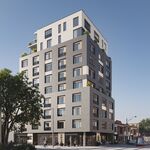Q: With regards to the original Scarborough-Malvern LRT route from Transit City, is there a reason why it wasn’t an eastern extension of the Eglinton LRT? I kind of like the idea of the LRT running the whole width of Eglinton, maybe even into Mississauga in the very long term.
Steve: Because the Scarborough-Malvern line has lower projected demand, it was considered as a second-phase project. Now, thanks to Metrolinx, it has fallen off the table completely and is not part of even their “Next Wave”. If Toronto does extend the Danforth subway east to McCowan, this will probably kill off hopes for an Eglinton East LRT, at least as a through route, as it might be considered to be a duplication. Meanwhile, the “Morningside Hook” from Sheppard down to UTSC also sits on the back burner. It was on the verge of formally becoming part of the Metrolinx plan, but then Rob Ford was elected and everything stopped.
Q: For the future west extension, do you prefer it running in the centre of the street like it will in the east or along the Richview corridor in a trench or something of that nature?
Steve: The Richview corridor is no longer available as a continuous path west of Jane because the City has declared parts of it surplus and sold the lands for redevelopment.
I know that some of the traffic engineers just love the idea of a trench because it puts the LRT out of the way. However, this would require considerably more land (compare to the width of the subway right-of-way north of Rosedale) because there is a limit on the slope of a hill. Alternately, the line could run in an open concrete box taking less space, but also a lot less attractive. Grade separating it in this way would trigger accessibility issues at stations and add to their cost.
It has always been amusing to hear two conflicting arguments that run roughly like this:
A surface LRT will interfere with other traffic and make intersection operations difficult especially with a “side of the road” alignment.
The demand west of Jane is insufficient to justify an LRT and therefore we should just run buses.
These are arguments of convenience trotted out depending on the position the speaker is advocating. An alternative viewpoint is that the corridor will grow eventually, and a rail link (and not UPX) to the airport employment area, not just to the air terminal, would be a major improvement for access from the east. We keep talking about the importance of the airport as a major transportation node, but other than a few showcase projects, we don’t actually do much to serve it or its considerable employment district.





